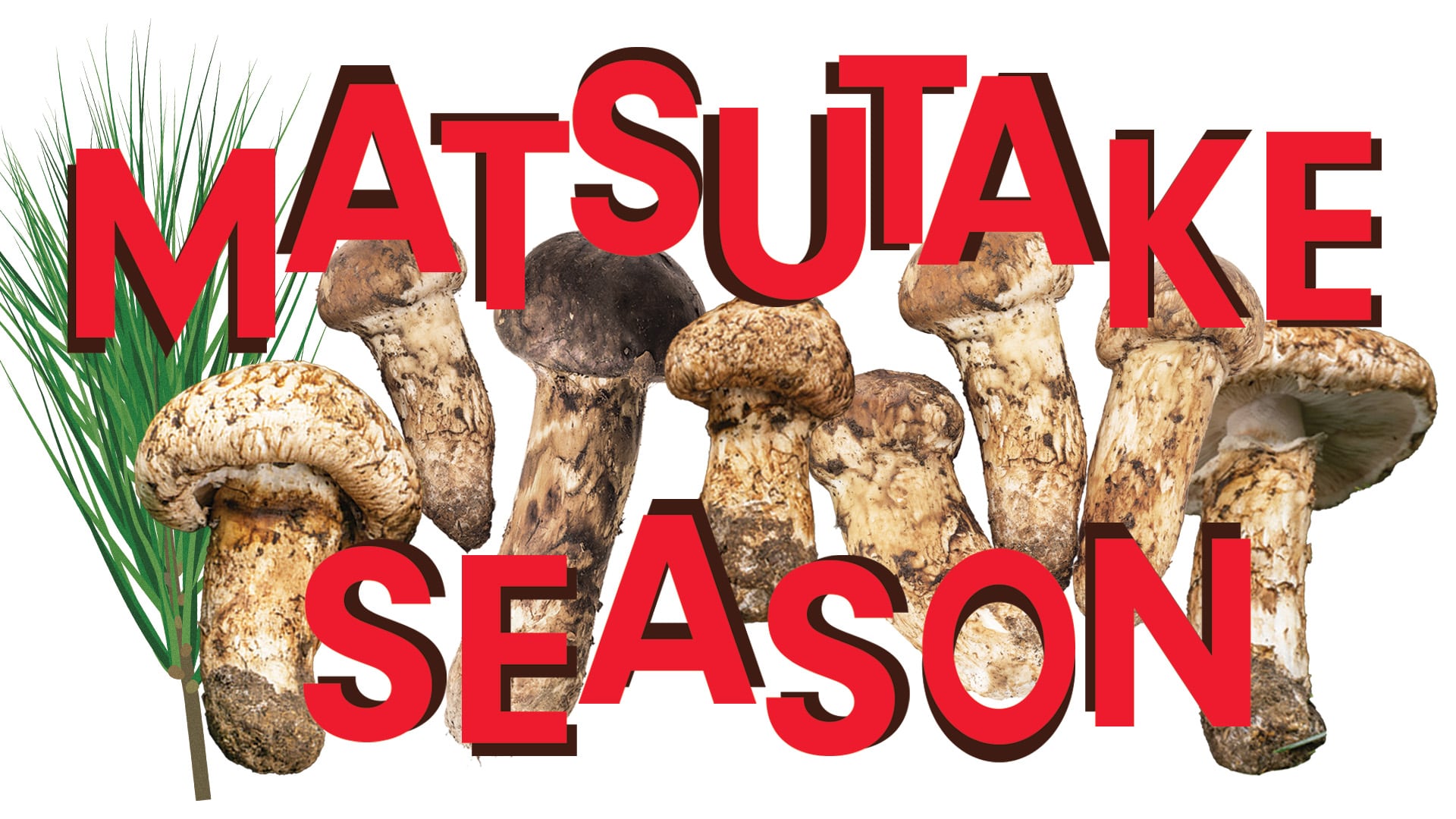As this newspaper went to press, much was still unknown about the future of Portland. And America, for that matter. If you visit wweek.com over the coming days, you’ll find our coverage of results from the first ranked-choice election in city history—featuring a pivotal mayor’s race and 12 open seats on an expanded City Council—as well as ballot measures with the potential to reshape Oregon life and commerce. If the nation’s nervous breakdown sparks tumult in Portland’s streets, we’ll address that, too. We don’t know any more about the future than you do, but we bet it’s going to be an eventful week.
Be honest: Wouldn’t you rather be in the woods, hunting mushrooms?
We thought you might. That’s why we decided to feature a palate cleanser in the form of an excerpt from Lola Milholland’s memoir Group Living and Other Recipes.
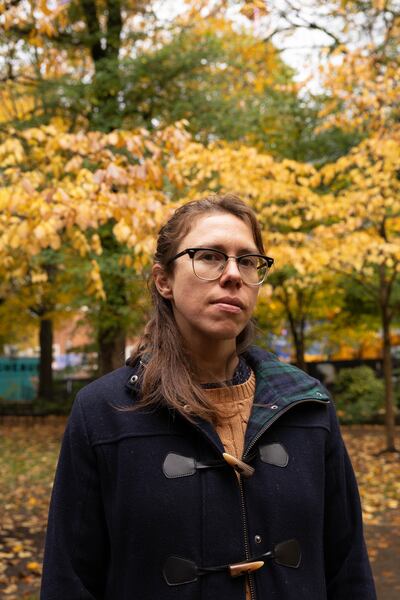
The book tells the story of how Milholland’s parents—a mother who managed Food Front organic grocery, a father who edited an alternative culture magazine—bought a house in the Piedmont neighborhood of Northeast Portland and opened it to whoever happened to be in town. As an adult, Milholland moved back into the Holman House with her brother and began her own adventure in communal living, often with several Laika animators helping with the group meals.
In a memoirist’s spin on Nora Ephron’s Heartburn, Milholland concludes each chapter with a recipe. You open the pages and smell the steam wafting out of the kitchen. Indeed, for any Portlander who has ever lived in a house with a nickname, or stumbled into a basement show where half the crowd would be spending the night, the book summons almost painfully vivid memories.
Little wonder that Group Living has been the toast of Portland’s literary scene for much of the fall. Several publications have interviewed Milholland, and our own cooking columnist, Jim Dixon, featured one of the book’s recipes in August. There’s a good chance this book is already on your holiday shopping list for the special hippie in your life. (If you’re looking for other books to give, check out page 16.)
So why feature it now? We were struck by a chapter late in the book in which Milholland accompanies her friend Amy Peterson on a matsutake hunt, joining as an outsider to a tradition kept by generations of Japanese Americans. Foraging for fungi defines an Oregon autumn—and perhaps something about being rooted resonates especially strongly at a moment when so much feels unmoored.
We’re not offering what follows as a retreat or escapism, even if that’s tempting right now. Instead, it’s meant to be a reminder in a divisive time that it’s the connections between people that matter, whether they’re found in a kitchen or on the side of a volcano. At the end of the story, you’ll find a recipe. Maybe you’ll make it with someone you love. —Aaron Mesh, Managing Editor
Excerpted from Group Living and Other Recipes. Copyright © 2024 by Lola Milholland. Excerpted by permission of Spiegel & Grau, New York. All rights reserved. No part of this excerpt may be reproduced or reprinted without permission in writing from the publisher.
Amy calls it Power Hunting. We’re driving toward a lake on the south side of Mount Hood, cruising slowly and peering into the forest, when suddenly she hits the brakes, jumps out of the car, and runs up the hillside. I see her bright-orange T-shirt puffing out from under her coat like a tutu as she takes rapid little steps through the trees. It’s a gray, chilly, and damp November day, but no matter how cold, Amy is usually in shorts and cushioned running shoes. I follow her up the hillside, where she calls out, “Not skunked!”—meaning, “I found one!”
“See anything?” she asks as I get closer, her eyes gleaming. It’s a test. There is a matsutake in sight. With so many steps taken, can I make the last one?
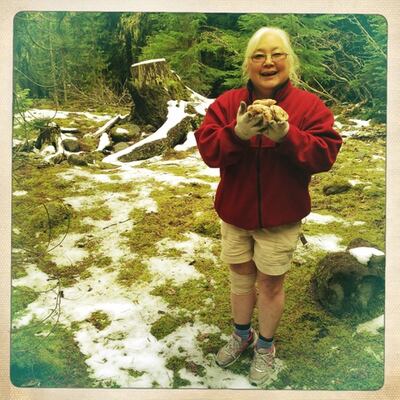
Power Hunting means hunting by car, going where you know the matsutake are and seeing if they’re peeking out. Most of the time, though, Amy and I hunt for mushrooms the normal way, on foot, stalking through the woods with a basket or a bag. Amy Peterson is in her late sixties, around four feet ten inches tall, with transition-lens glasses and an external hearing implant behind one ear. “One ear has the best hearing the doctor ever tested,” she tells me, “and the other is useless.” Raised in Boring, Oregon, the grandchild of Japanese immigrants, Amy spent many of her childhood weekends on Mount Hood, hunting matsutake and bracken fern. She tells me of years her family would gather rice sacks full of the mushrooms, which they canned for the winter.
Around twelve years ago, my friend Raf’s mom, Valerie—knowing I’m gaga for mushroom hunting—invited me to join the annual matsutake hunt that Amy and her cousins lead each year for nikkei, descendants of Japanese immigrants. It felt like being invited inside the Magic Castle. Our group consisted mostly of older Japanese Americans, though non-nikkei friends and family were invited to tag along.
Matsutake, or “matsis,” as Amy calls them, are prized in Japan, where they fetch handsome prices, for their complex aroma. I’ve heard people describe this scent in many ways: cinnamon, Red Hots, old socks, ripe cheese, earth, and spice. (Just “spice,” like in Dune.) For me, the experience of smelling a matsutake is like being attracted to someone else’s body aroma, my adrenal system responding independently of my mind.
In Anna Tsing’s book The Mushroom at the End of the World, she describes how the logging of cedar and cypress forests around Kyoto to build temples left behind denuded, sunny hillsides, which favor pine trees—and therefore their symbiotic partners, matsutake (in Japanese, matsu is “pine” and take is “mushroom”). Their aroma reminded Kyoto citizens of the grander forests that once stood there, a memory that Tsing argues is collective rather than personal. For contemporary Japanese, matsutake smell of a natural world they’ve largely cemented over. Since they lack an adequate domestic supply to feed their appetite, they’ve built informal economic supply chains to bring them matsutake from all over the globe.
For the first Japanese immigrants to Oregon, the matsutake they found in the forests where they worked as loggers smelled of a country and culture they longed for. In 1942, a few months after the bombing of Pearl Harbor, in a moment of irrational paranoia and racism, President Franklin D. Roosevelt hastily signed Executive Order 9066, sending around 112,000 US citizens of Japanese ancestry in the West to concentration camps in remote, often desert locales. The War Relocation Authority assigned around thirty-three thousand of these people to seasonal or annual farm labor.
Many Japanese Americans lost their homes, farms, and businesses. Amy’s dad’s family went to the farm-labor camps in Nyssa, Oregon, to grow sugar beets, which became critical to the war effort; they were made into alcohol, which was then used to create synthetic rubber and munitions. (In 1943, newspapers reported that “every time a 16-inch gun is fired, a fifth of an acre of sugar goes up in smoke.”) Her mom’s family went to Tule Lake in Northern California, where her brother-in-law and cousins helped build the barracks that would later house a group known as the No-No Boys—Japanese American men who answered “no” to two questions on a government-loyalty test administered to all detainees in 1943. Her mom, uncles, and grandfather were then moved to Heart Mountain, Wyoming. Amy’s parents married after the war, and she was born in 1954.
Living in the aftermath of internment, judged guilty without trial and afterward left with the burden of proving their loyalty to the United States, Japanese Americans have been adept at creating new lives and finding steady, well-paying jobs. But there’s a divide between public and private life for many Japanese Americans. In public, especially immediately after the war, their Japaneseness could be a liability, so it was often masked. In private spaces, however, they celebrated their heritage and continued to evolve it. Matsutake culture exists in this sphere—as an intimate activity that brings Japanese Americans together, ignites memories, and reaffirms their relationships with the land.
For Amy, hunting matsutake is less about a connection to Japan, a place she first visited in 2018. Instead, the hunt connects her to Oregon. Every fall she visits what she calls “my mom’s tree,” an old pine where her mother always found “dinner-plate-sized matsis.” She crawls over the craters and underbrush, knowing which trees have been productive in the past. She and her family complete this fall ritual by making matsutake rice and sukiyaki, a delicious and decadent hot pot with thinly sliced marbled beef and loads of matsutake, both perfect ways to capture and convey the mushroom’s potent aroma.
I was starting to see group living outside the home enacted within these seasonal rituals, which are connected to place and anchored in the pleasures of community. I’d long been uneasy with the kind of group-making formed around flags and declarative exclusivity. James Baldwin’s words from The Fire Next Time rang true: “People always seem to band together in accordance to a principle that has nothing to do with love, a principle that releases them from personal responsibility.” My Japanese American friends were showing me a different way of building bonds. Admittedly, what brought them together was a shared cultural heritage. At the same time, they were eager to share their love of food and traditions with new people. They renewed their relationships to one another and to their history and the natural world by foraging, clamming, farming, gardening, cooking, and eating together.
Their practices required deep noticing, and because those practices were honed across generations, they were accompanied by all kinds of sweet details. A friend I met on a hunt carried her mother’s old mushrooming stick. It had a bit of tinfoil wrapped around the end so that if you set it on the forest floor, the glint would help you find it again. Amy and her friend Connie always shared their matsutake harvests with people too old to join the hunt and relatives who’d moved away. Sharing and remembering were part of the pleasure. When the coronavirus narrowed our social lives, they continued to check in on elders and bring them food, because these acts of care were integral to their routines. These women built a web around the people in their greater community. You didn’t have to be Japanese American to enjoy stalking the woods with them. Each fall, these hunts gave me a new feeling of home.
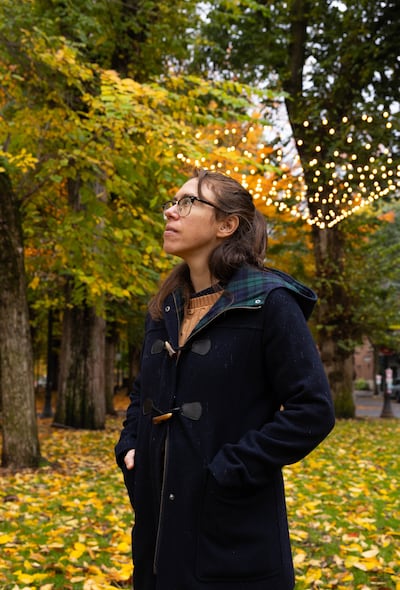
Matsutake still tease me with coy distance and appeal. After years of Amy’s mentorship, I’m getting better at finding matsutake, but the hunt can be like the cruelest game of Where’s Waldo? Often the mushrooms are underground and out of sight. The first clue they offer to hunters is a little bump as they begin to surface. I, however, can’t differentiate the tufts of dirt and needles the mushrooms raise from other disturbances in the duff. I find myself poking into empty holes like a daft squirrel who’s lost her acorns.
The second clue, for the very adept, is the aroma. I can’t smell matsutakes when they’re belowground, although I once witnessed a hundred-year-old Japanese American man take a deep sniff, poke a stick into the ground, and emerge with a mushroom almost as long as his forearm. So it can be done. From a distance, I’m sometimes duped by a fatal mushroom charmingly nicknamed the “Angel of Death,” which is also a dirty white. Luckily, up close it looks and smells like chalk.
But despite my middling success, I love the hunt, the company, and the familiar cycle, so I eagerly follow Amy into the forest. Starting in midsummer, when experienced hunters begin their pursuit, Amy heads to nearby volcanoes to begin gathering and freezing matsutake for a sukiyaki-dinner fundraiser for the Oregon Buddhist Temple and matsutake rice for New Year’s boxes. She also scouts spots for the fall guided trip. I sometimes join her in these early season hunts.
In my mind, mushrooms occupy the same liminal territory as the narwhal—a realm where fantasy and reality overlap, where the music of childhood keeps playing unexpectedly into adulthood. What we call a mushroom is the fruit of a much larger organism called mycelium, a network of spiderweb-like threads that spread underground. Mycelium is the vegetative portion of the fungus: think of the roots, branches, and leaves of an apple tree. How large are mycelia? Dan Luoma, a professor at Oregon State University, describes walking through the forest as walking on the backs of whales. But it’s the mushrooms, which pop up seasonally, that facilitate reproduction, by spreading microscopic single-cell units called spores. One mushroom will drop as many as sixteen billion spores during its lifetime, and these spores are easily picked up by the wind.
“Every breath that we take—from first gasp to last breath—we’re inhaling fungal spores,” Nicholas Money, author of Mushrooms, said in a radio interview. “They’re always available; they’re always in the air; and they’re always trying to exploit the opportunities to grow and reproduce.”
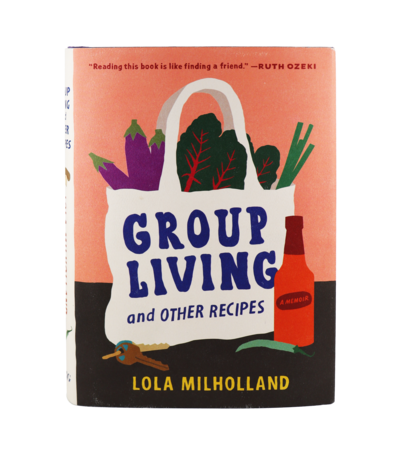

The mushrooms I hunt and eat fall into a category called mycorrhiza. These mushrooms, including matsutake, chanterelles, morels, and porcinis, exist in symbiotic interdependence with the roots of trees. Mycelium nourishes itself by absorbing nutrients from organic material. It secretes enzymes that break down its food into more easily digestible units (like our saliva does when we chew). By decomposing whatever it feasts on and by increasing the surface area of the roots, mycelium makes it easier for those roots to uptake gas, water, and nutrients like nitrogen and phosphorus. The mycelium acts as an extension of the plant’s digestive system. The trees, in turn, give it carbon, obtained through photosynthesis. It’s a mutually beneficial relationship. Nutrients can move between plants through fungal networks, and research shows that, along with nutrients, mycelia transmit signals from the largest, oldest “mother trees” to younger ones to maintain the overall health of the stand.
The forest is acting like one large organism, connected through mycelial networks, concerned for its overall health rather than individual survival—a kind of selflessness that doesn’t correspond neatly to our understanding of the survival of the fittest. Paul Stamets, a mushroom guru with a cultlike following warranted by his expansive research on mushrooms, including their power to remediate polluted land, calls mycelium “nature’s internet.” He estimates that 90 percent of plant life depends on mycorrhizae.
Mycorrhizal mushrooms remind me that all life is interdependent. Our borders are porous. What’s happening on a small scale with a mushroom (giving and receiving life from trees and other plants) is true of all life on earth. Our health and every (spore-filled) breath we take relies on the actions of plants, animals, and fungi all around us. Mushrooms offer a different vision of survival—not conquering or dominating but collaborating for mutual benefit.
We often use the violent language of human power dynamics as metaphors to talk about plants and animals, and vice versa: parasitic plants and parasitic boyfriends; fungi that colonize and colonizers who rape the land. There are kings of the jungle and financial predators.
In a gentler turn of that formula, my favorite metaphor for group living, when it works, is a mycorrhizal network. We are all giving and receiving, and through those interactions, we become like one organism. This is true for any group that values its holistic health—the microcosm underground as the macrocosm of our lives.
The mushroom world is famous for its reclusive community of survivalists, type A taxonomists, biologists, ecologists, spiritualists, homesick immigrants and their children, hippies and their children, and chefs. Like the scent of matsutake, the musky fragrance emanating from this hodgepodge group attracts me. Finding mushroom people has become its own kind of hunt. Once, looking for matsutake in the woods, I happened upon an old man with a cherubic face, wispy white hair, wire-frame glasses, and smiling eyes gathering white chanterelles and truffles. He introduced himself as Dan Wheeler, president of the Oregon Mycological Society in 1992 and 1993 and longtime president of the Portland chapter of the North American Truffling Society.
I found no matsutake on that hunt, but as he walked me out of the forest to our cars, he told me about his early work to promote and distribute the Oregon white truffle. Wheeler, who had a truffle named for him, Tuber wheeleri, claimed to have inoculated the first native truffles in a Douglas fir stand. At that moment, I wondered if I liked finding mushroom people at least as much as mushrooms.
Many devoted mushroom foragers, including commercial pickers, crave invisibility and choose to exist primarily in the alternate reality of the forest. Amy introduced me to Matsiman, who lives off the grid somewhere in southern Oregon and researches the connections between matsutake and precipitation. As a kid, I met Hmong and Lao commercial pickers in central and eastern Oregon forests, whose camps approximate their former lifestyles in Southeast Asia. Some foragers, like Amy and me, only crave regular visits to the forest, which provide an escape from life in the city.
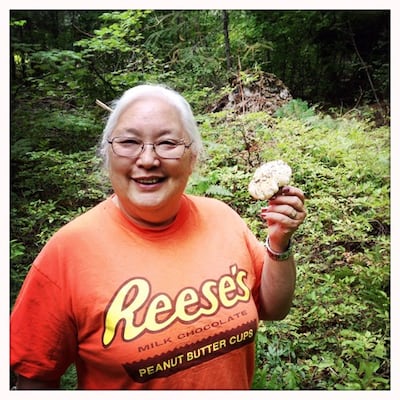
Loving and delighting in these oddballs helps me continually recalibrate my sense of self-worth. Watching Amy hustle up and down hillsides, feeling waves of affection for her, I find a peaceful glee that visits me most often when I’m in the forest. Amy moves with agility and focus, but her manner is giddy and childlike, full of energetic curiosity. She usually puts her long silvery hair up in a loose bun held aloft with a pen, but while she’s tracking through the forest, the pen always seems to slip out and the bun slowly unravels without her realizing. When I notice Amy’s hair coming undone, she reminds me of myself, even though she’s thirty years older, Japanese American, a longtime Girl Scout leader, a Buddhist, a Disney fan, a teetotaler, and a mother of two: nothing like me, really, at all. But she has a sparky horse-power, like a little truck—vroom, vroom, let’s go, let’s go—a goofy carelessness with her appearance, and an eagerness to please and involve other people. I feel completely at ease in her presence, and more at ease with myself.
For years, Amy wore a neon-orange Reese’s Peanut Butter Cup T-shirt on every hunt. She got it for free at her security job at Costco and used it like a hunter’s vest, to signal her movements among the trees. Lately, in a cheeky turn, she’s started wearing a psychedelic tie-dye T-shirt of an orange mushroom radiating green, blue, and purple flames that you’d more likely expect to see on a Phish fan than on a Costco security guard who doesn’t drink or do drugs. But its brightness has the same lighthouse effect, and I follow her beam wherever she tracks. Even though we’re foraging matsutake, half the hunt is complete for me: I’ve already found the mushroom person I was looking for.
Amy’s Matsutake Rice and Onigiri (Rice Balls)
Inspired by Amy Peterson, recipe by Lola Milholland
MAKES 4 SERVINGS, OR 8 TO 10 RICE BALLS
Matsutake are best cooked in ways that amplify and encapsulate their powerful aroma—they’re not a mushroom you should ever sauté in oil. Steaming rice with matsutake allows a handful of mushrooms to infuse an entire pot of rice. Amy doesn’t make small quantities of matsutake rice—she’s always making it to share—so I’ve shrunk and adapted her recipe. My favorite way to eat matsutake rice is as an onigiri with the Korean-style seaweed called gim gui, which is fried in toasted sesame oil. Japanese nori also works great.
Rice balls are a perfect food for taking on a mushroom hunt. If you can’t get your hands on matsutake, use a combination of maitake and shiitake. I love matsutake rice with a side of miso soup and something crunchy, like a pickle or a salad. You can make this in a rice cooker or on your stovetop—I’ve included instructions for both. For the stovetop, be sure to use an enamel or cast-iron pot with a heavy bottom and a tight-fitting lid.
- 2 cups Japanese short-grain rice
- 6 ounces matsutake (or substitute a combination of maitake and shiitake)
- ¼ cup soy sauce or tamari
- 1 tablespoon mirin
- ½ teaspoon salt
OPTIONAL
- ½ pound boneless, skinless chicken thighs, cut into small bite-size pieces
- 2-by-3-inch piece kombu seaweed
Rinse the rice in several changes of cold water until the water almost runs clear. In the bowl of your rice cooker or pot, add the rice and cover with water by an inch or so. Set aside. After 30 minutes, drain the rice in a strainer and set the strainer aside for 15 to 30 minutes to air-dry. This helps the rice cook perfectly.
Matsutake are often sandy. Clean them using a small brush or by swishing them aggressively in water. Slice the mushrooms thinly.
Combine 2 cups of water with the soy sauce or tamari and mirin. Place the rice, water, soy sauce or tamari, and mirin in the bowl of your rice cooker or pot. Place the mushrooms on top of the rice. Sprinkle the salt over the mushrooms. Add optional chicken, if using, on top of the mushrooms. Set optional kombu on top of the mushrooms or chicken. Do not stir anything into the rice—let everything sit on top.
If using a rice cooker, close the lid and set to cook, following the instructions of your device. For the stovetop, place your pot over high heat and bring the water to a boil. As soon as bubbles are visible, immediately turn the heat to low, cover with a lid, and cook for 25 minutes or until all the water is absorbed. Turn off the heat.
After the rice cooker clicks to “warm” or you turn off the heat, let the rice stand, covered, for 10 to 15 minutes. Discard the kombu. Using a rice paddle or spatula, gently fold the mushrooms and chicken into the rice, bringing the bottom to the top and vice versa. Let stand, covered, for another 5 minutes. You can eat the ice as is or make yourself rice balls following the instructions below.
Onigiri
Once your rice has cooled just enough to handle (it should still be hot), fill a bowl with ice water. Dip your hands in the water and clap once to remove any excess. Grab a handful of rice a little smaller than a baseball. Form a loose ball with the rice, just compact enough to hold its shape. You can stop right here—you have a nice round rice ball! If you want to make a traditional triangular shape, like the roof of a wooden block set, squeeze gently from the bottom with one hand while shaping the top into a roof with the other. Rotate the triangle in your hands three times, squeezing, so every side is uniform.
To make more, dip your hands in the cold water and clap each time before forming a rice ball. Wrap each in plastic wrap or place inside a container with a lid. Rice balls taste best when kept outside of the fridge and eaten within one day, but you can store them in the fridge for up to a week or in the freezer for several months. Just be sure to reheat fully before eating. Only when you’re ready to eat, pull out the gim gui (Korean-style seaweed). Cut each sheet of seaweed in half and wrap one half around an onigiri. Eat before the seaweed goes limp!
